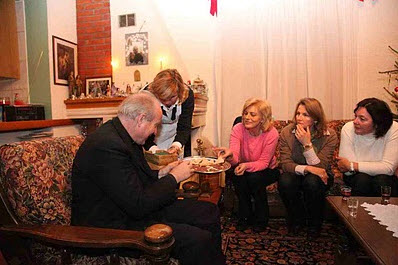Compiled by Andrew Jerome Yeung.
Copyright 2017 © by Dr. Jennifer Yeung.
All rights reserved.
PREFACE
By Marija Stelzer-Dugandžić
[Native of Medjugorje. Close friend of the visionaries. Graduate of the prestigious Pontifical Gregorian University in Rome. Licentiate in Pastoral Theology from the University of Vienna. Author of Our Lady Speaks As A Mother – Textual Analysis and Theology of the Messages of Medjugorje (Informativni Centar “Mir” Medjugorje).]
Cardinal Christoph Schoenborn

Pictured from left to right: His Eminence Christoph Cardinal Schoenborn, Marija Pavlović, Mirjana DragiČević, Marija Stelzer-Dugandžić and Ivanka Ivanković.
Since 1981, six Croatian youths in the village of Medjugorje, Bosnia-Hercegovina, have been asserting that they see the Blessed Virgin Mary and that they receive messages from her. For millions of people all over the world these extraordinary events, together with the heavenly instructions, have become a source of renewal within their Christian lives. The messages are in complete harmony with the Gospel and with Catholic Tradition.
Although the Church’s position on the occurrences was, at that stage, one of investigation and watchful attention, unofficial pilgrimages to Medjugorje were neither prohibited nor discouraged. On the contrary, the Church acknowledged this village to be a sanctuary of prayer, and oversaw the liturgical-pastoral services offered at the site by the Franciscan priests and sisters.
Through Medjugorje, thousands upon thousands of Christians and non-Christians have found their way to God, to one another, and to the Church; this is what most characterizes Medjugorje, described by someone as “a place where it is very easy to turn to God and to start a new spiritual life.” Countless visitors have experienced conversion and various forms of healing.
In 2010, the Archbishop of Vienna, His Eminence Christoph Cardinal Schoenborn, main editor of the Catechism of the Catholic Church, opened the fourth decade of the reported apparitions by celebrating Holy Mass in Medjugorje on New Year’s Day. He stated: “When you look at a place like Medjugorje, you can see a superpower of mercy… This is my first visit, but since I’ve been a Bishop, I have simply noticed the fruits of Medjugorje.”
“I would be lying if I said this fruit did not exist. This fruit is concrete and visible, and I can see in our diocese and in many other places graces of conversion, graces of a supernatural life of faith, graces of joy, graces of vocations, of healings, of people returning to the Sacraments, to Confession. All this is not misleading. Therefore, as far as I am concerned, as a bishop, I can see the fruit. If we had to judge the tree by its fruit, as Jesus recommended, I must say that the tree is fruitful.”
The Cardinal’s observations about the return to the Sacraments can be partially attested to by the large number of communicants and Confessions at Medjugorje. There are at least six Masses celebrated each day inside St. James’ church and/or the outside altar. During the summer months, each one is overflowing with pilgrims – more attendants than on Sundays in most churches in the Western world. As well, in the Adoration chapel, morning Masses are said hourly for ethnic groups from around the globe. Every year, the number of communion hosts used far exceeds 1,000,000.
As to Confessions, there are six confessionals inside the church and sixty-one outside. Dozens of extra stations are set up around the grounds on big feast-days. The queues are long.
Andrew Jerome Yeung, the writer of this compilation, travelled to Medjugorje numerous times. He is one of those for whom this hamlet became a second home. Staying there for several weeks on some occasions, he witnessed and personally experienced the intense response to Our Lady’s call in the surroundings in which they were given. He learned to speak a little Croatian, and made many friends among the parishioners, the visionaries and the pilgrims.
The six books he wrote, plus a seventh available only on www.medjugorjeca.org, are all influenced by the Queen of Peace in one form or another. In fact, the only reason he came originally to the shrine in 1984 was to ask the Mother of God for counsel and direction on his first one: DO WHATEVER JESUS TELLS YOU! which eventually took him till the forty-seventh year to finalize. The sayings quoted in it are exclusively those attributed to Jesus by the Evangelists in the Four Gospels. It is a powerful instrument in helping to crush the serpent’s head.
I consider Our Lady Speaks from Medjugorje an immensely precious contribution to understanding the communications of the Blessed Virgin. Putting the more important subjects in alphabetical order, Andrew assists us in finding an easy entrance to the riches of the wonderful guidance given by our loving Mother. On the one hand, for those who do not know them or who reject them purely out of ignorance, it gives a quick and clear view of what Mary is saying. On the other hand, for those who do know them and want to live them more fully, this systematic manual will be useful in their meditations and in the revitalization of their faith.
I hope this work fulfils the author’s wish of bringing to the reader the immeasurable joy of becoming a better Christian. I hope it will serve as an inspiration for all to come closer to God, and to learn to pray and offer up their lives for the conversion of sinners and unbelievers. I hope also that priests and deacons will find in it valuable reminders for their preaching, leadership, and proclamation of the Gospel of Jesus Christ.
[The above-mentioned book DO WHATEVER JESUS TELLS YOU! can be read in “Spiritual Readings” (and an older version can be heard in “Audio Teachings”) at this same web-site: www.medjugorjeca.org.
The book can be obtained at the Medjugorje Centre of Canada, Toronto. Telephone 416-900-1623. E-mail: admin@medjugorjeca.org ]